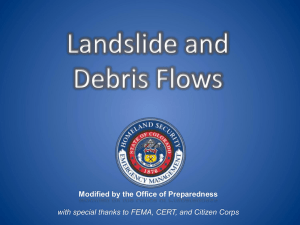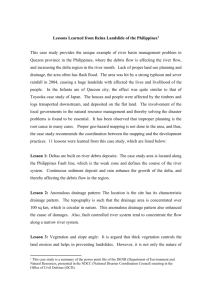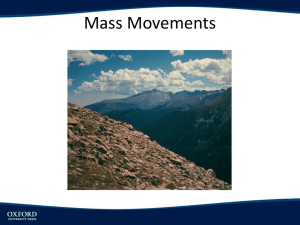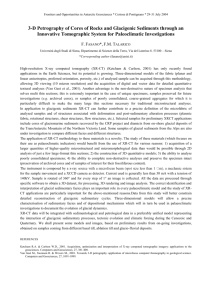THE BIG’95 DEBRIS FLOW AND ADJACENT UNFAILED SEDIMENTS IN
advertisement
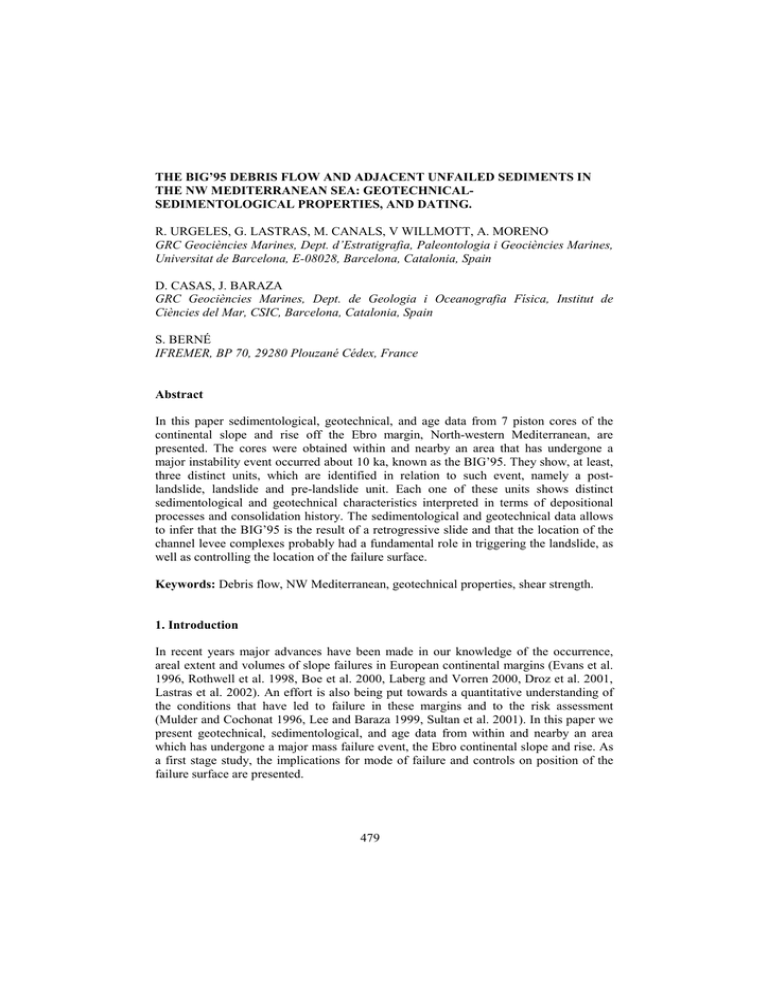
THE BIG’95 DEBRIS FLOW AND ADJACENT UNFAILED SEDIMENTS IN THE NW MEDITERRANEAN SEA: GEOTECHNICALSEDIMENTOLOGICAL PROPERTIES, AND DATING. R. URGELES, G. LASTRAS, M. CANALS, V WILLMOTT, A. MORENO GRC Geociències Marines, Dept. d’Estratigrafia, Paleontologia i Geociències Marines, Universitat de Barcelona, E-08028, Barcelona, Catalonia, Spain D. CASAS, J. BARAZA GRC Geociències Marines, Dept. de Geologia i Oceanografia Física, Institut de Ciències del Mar, CSIC, Barcelona, Catalonia, Spain S. BERNÉ IFREMER, BP 70, 29280 Plouzané Cédex, France Abstract In this paper sedimentological, geotechnical, and age data from 7 piston cores of the continental slope and rise off the Ebro margin, North-western Mediterranean, are presented. The cores were obtained within and nearby an area that has undergone a major instability event occurred about 10 ka, known as the BIG’95. They show, at least, three distinct units, which are identified in relation to such event, namely a postlandslide, landslide and pre-landslide unit. Each one of these units shows distinct sedimentological and geotechnical characteristics interpreted in terms of depositional processes and consolidation history. The sedimentological and geotechnical data allows to infer that the BIG’95 is the result of a retrogressive slide and that the location of the channel levee complexes probably had a fundamental role in triggering the landslide, as well as controlling the location of the failure surface. Keywords: Debris flow, NW Mediterranean, geotechnical properties, shear strength. 1. Introduction In recent years major advances have been made in our knowledge of the occurrence, areal extent and volumes of slope failures in European continental margins (Evans et al. 1996, Rothwell et al. 1998, Boe et al. 2000, Laberg and Vorren 2000, Droz et al. 2001, Lastras et al. 2002). An effort is also being put towards a quantitative understanding of the conditions that have led to failure in these margins and to the risk assessment (Mulder and Cochonat 1996, Lee and Baraza 1999, Sultan et al. 2001). In this paper we present geotechnical, sedimentological, and age data from within and nearby an area which has undergone a major mass failure event, the Ebro continental slope and rise. As a first stage study, the implications for mode of failure and controls on position of the failure surface are presented. 479 480 Urgeles et al. 2. Geological setting The Ebro margin is located on the western side of the Valencia Trough, an early Miocene-Pleistocene extensional basin (Díaz del Río et al. 1986, Clavell and Berastegui 1991) that lies between the Balearic Islands and the Iberian Peninsula. Figure 1. Left, 3-D block with overall morphology of the Ebro margin and boundaries of the BIG’95 debris flow. Location of the studied cores is also presented. Right, very-high resolution parametric profile of within the landslide mass showing transparent acoustic facies for the BIG’95 on which areal mapping is based. Figure 2. Backscatter strength derived from the EM-12 multibeam echosounder with location of the studied cores and debris flow boundaries. Note patches of low backscatter strength surrounded by high backscatter stripes. The area of study has undergone a major instability event in the form of a debris flow named BIG’95 (see Lastras et al. 2002, Figures 1 and 2). The landslide involves 2,200 km2 of seafloor (4 times the area of the nearby island of Eivissa), and has a volume of Sedimentological and geotechnical properties of debris flow 481 3 26 km . It affects the Ebro slope and base-of-slope at depths ranging from < 600 to 2000 m. Swath bathymetry data (Lastras et al. 2000, 2002, this volume) have shown an area of uneven topography in the Ebro slope with several main and secondary scars identified between 600 and 1200 m deep (Canals et al. 2000, Lastras et al. 2000). TOPAS parametric records show a large (2000 km2) sediment body with transparent seismic facies covering the entire sea floor (Figure 1b), thus indicating the event’s youth. EM12 backscatter strength images (Figure 2) show that the debris flow area consists of a pattern of low-backscatter patches, representing large blocks of sediment, which moved down-slope partially keeping their internal coherence, separated by topographically depressed lineations of high backscatter representative of coarse sediment pathways that partially buried at their terminus the uppermost course of the Valencia Channel (Lastras et al. 2002). The large sediment blocks appear only between 1200 and 1550 m water depth, while coarse sediment paths are present all along the debris flow. 3. Methodology The cores used in this study were obtained in 1997 from on board the French N.O.C.I. L’Atalante. The coring was accomplished using a piston corer, which recovered 7 cores of lengths between 3.1 and 8.6 m. The cores were logged on board with GEOTEK’s multisensor core logger, which is composed of a thermometer, displacement transducers, a source and detector of 137Cs, piezoelectrical transducers measuring the speed of sound, and a susceptibilimeter. This allowed measuring the density of the sediment from the attenuation of the gamma rays, the speed of sound, and the magnetic susceptibility, a good indicator of variations, size, nature and concentration of ferromagnetic minerals. Porosity can also be calculated from the sediment density if the sediment is fully saturated, and the mineral grain density and fluid density are known or can be sensibly assumed. The cores were later split in Barcelona where the following analyses were performed: grain size using the settling tube and a Sedigraph 5100D for the coarse and fine fraction respectively; water content weighting before and after drying the samples in an oven at 105ºC and correcting for salinity; shear strength and remoulded shear strength analyses using a vane device; and carbonate content by pressure calcimetry. Age determinations using the AMS 14C technique were carried out at the Utrecht University AMS facility in specimens of G. ruber and G. Bulloides at two specific cores (CLKS01 and CLKS06). The weight of carbon material used for dating ranged between 0.42 to 0.81 mg. 14C ages were corrected for the reservoir effect and converted into calendar years using Calib4. The core data were introduced into EarthVision© well-log database for further analyses, combination with swath bathymetry data and digitised depth-to-base of debris flow from TOPAS very high-resolution seismic profiles and, finally, 3-D data display. 482 Urgeles et al. 4. Results 4.1 SEDIMENTOLOGY The cores can be a priori divided between those collected from within the landslide mass (cores CLKS01, 04, 05, 06 and 07) and those collected from adjacent non-failed areas (cores CLKS02 and 03), according to the acoustic response from the TOPAS profiler (Figure 1b). The first ones show two or three distinct units depending on whether they cored pre-landslide material or not. From top to bottom they show an upper unit of quite homogeneous brownish clays and/or clayey silts (8-9 phi, Figure 3) with abundant foraminifera and occasionally other fossil specimens, which is interpreted as post-landslide hemipelagic sedimentation. Surprisingly, the most distal core (CLKS07) shows a 10 cm layer on top of the unit with relatively coarse black sands, which probably represent a very recent instability/turbidite event. Figure 3. Mean grain size, water content and density logs for the set of studied cores. The lithology log shows post-landslide sediments (light grey), landslide sediments (dark grey) and pre-landslide sediments (black). Cores are sorted from left to right from shallow to deep. All scales are proportional. For location see Figures 1 and 2. The second unit shows typical debris flow facies with convoluted laminations of interbedded sands, silts and silty clays of grey to dark brown colours. Some cores, such as CLKS06, obtained near an area of high backscatter, show a massive level of sand on top of this second unit. The fossil content is relatively low and the boundary between this unit and the upper one is usually bioturbated. Among the cores collected within the landslide mass, the third unit, the deepest one, is found only on cores CLKS01 and CLKS04 located on the shallower areas and on the margins of the debris flow respectively. It is interpreted to be constituted by sediments predating the landslide and, together with the upper post-landslide unit, are those found outside the debris flow area, the area of well stratified reflectors in TOPAS records. Sedimentological and geotechnical properties of debris flow 483 These sediments are usually composed of grey massive (sometimes laminated) silty clays with little fossil content. Figure 4. Whole set of log properties for cores CLKS02 and CLKS03, showing contrasted sedimentological (mean, deviation and asymmetry of grain size, see also magnetic susceptibility) and geotechnical (water content, density and intact and remoulded shear strength) properties. All scales are proportional. Grey scale tone of label on top of the log corresponds to the log with the same grey-scale level. Outside the debris flow area (cores CLKS02 and CLKS03), all cores show the first uppermost unit with similar characteristics as those described previously. The sediment below this unit is also attributed to pre-landslide material and/or probably involved within the landslide mass. However, for the pre-landslide material, two types of sediments are found outside the debris flow area. Core CLKS03, the shallowest core, located on the open slope of the Ebro margin, mostly shows massive dark yellowish brown clays and silty clays; while core CLKS02, located on the flank of a levee shows interbedding of well-laminated clayey silts and sands (Figure 3). Core CLKS02 also has much larger deviations from the mean grain size and asymmetry values (Figure 4). Such interbedding is also apparent on the magnetic susceptibility logs as compared to the rest of the cores, which have a much more subdued signature (Figure 4). 484 Urgeles et al. 4.2 GEOTECHNICS The geotechnical parameters from the different cores also allow distinguishing the upper post-landslide unit, which shows a similar pattern through all the cores. This upper part shows high water contents (up to 80%) and corresponding low densities (Figure 3), as expected from a recently deposited sediment. The post-landslide unit has much lower shear strengths (around 5 kPa; Figure 5) than that of the sediments below (either landslide or pre-landslide sediments). The landslide sediments, i.e. those involved into the debris flow, have lesser amounts of water, and thus their density is also slightly higher. Water content is also slightly lower (by about 10%) than that of the pre-landslide sediments that have not been affected by the passage of the debris flow (cores CLKS02 and CLKS03). On the other hand, at the same consolidation stress, shear strength appears to be higher for the sediments involved into the debris flow than for those pre-dating the BIG’95 (Figure 5). However, the remoulded shear strength is similar (around 5 kPa) for both the BIG’95 and pre BIG’95 sediments. This is not a unique characteristic of the BIG’95 (see for instance Prior et al. 1984). It probably reflects that increased pore water pressures at the source area were involved in the genesis of the landslide, which turned into a debris flow. Destructuration of the sediment into the debris flow and consolidation after deposition has been able to dissipate such pressures (it has been shown that debris flows consolidate under their own weight after deposition takes place not during transport; Major 2000). Figure 5. Intact and remoulded shear strength logs. The lithology log shows post-landslide sediments (light grey), landslide sediments (dark grey) and pre-landslide sediments (black). Cores are sorted from left to right from shallow to deep. All scales are proportional. For location see Figures 1 and 2. The most striking difference arises when comparing the two cores obtained from the area non-affected by the landslide, CLKS02 and CLKS03, which physical properties most probably match those of the sediments affected by the landslide before it took place. They show quite distinct shear strength profiles (Figure 4), with CLKS03, collected on the open slope showing an increasing trend with depth and CLKS02, on the flank of the levee showing almost no increase with depth. This reflects a change in Sedimentological and geotechnical properties of debris flow 485 sedimentation rates according to the environmental setting, the ones on the levee, being probably much higher than those on the open slope (see next section for sedimentation rates), also probably reflecting than those of the levee are underconsolidated. It must be noted here, that both cores represent sediments coming from the same source area, and therefore it is expected that they have very similar plasticity indexes. 4.3 AGE DATING 14 C age dating in cores CLKS01, on the open slope, and CLKS06, at the base of the slope display consistent results with the sediments immediately above the landslide, yielding 14C ages of 9950 ± 50 ka in the first case and 10250 ± 60 in the second, which correspond to the intervals 11124-10979 and 11593-11531 calendar yrs BP. Age datings allow estimating sedimentation rates based on linear extrapolation between dating points. These rates are of 8.5 to 12.4 cm/ka in the slope to 2.9 cm/ka at the base of the slope (Figure 6). Figure 6. Age datings and extrapolated sedimentation rates on the slope and base of slope from cores CLKS01 (slope) and CLKS06 (base of the slope). 486 Urgeles et al. 5. Discussion and conclusions From the data presented above it is suggested that the BIG’95 was a major landslide event that took place at the end of the Last Glacial Maximum, at a time of global sealevel rising. The landslide sediments show different sedimentological and geotechnical characteristics than those post-dating the landslide unit, but also different from those of the source area with significant larger amounts of coarser material (even coarser than the sediments represented by CLKS02 on the flank of a levee). This can be interpreted in two ways: 1) the landslide climbed backwards due to the missing lateral support and affected sediments from relatively coarser more proximal areas; or 2) the landslide obliterated bodies of coarser material at their head such as channel-lag deposits that were not represented by our sampling strategy. These two options are not exclusive and swath bathymetry from the EM-12 echosounder provides evidence for both hypotheses (channel ghosts within the landslide mass and secondary scars above the main headwall). Backscatter strength images also provide evidence for different phases within the flow, as stripes of high-backscatter, supposed to be coarse material, surround low backscatter patches, which is supposed to be finer grained material (Lastras et al. 2002). This may originate in two ways depending on the source of the coarse and fine sediments. 1) A first phase were the landslide mostly affects fine grained material in the main scar, such as the one sampled in cores CLKS02 and CLKS03, and a second stage when failure probably climbs upwards involving coarser sediments that move between the blocks of more cohesive material triggered during the first phase. Or 2) triggering of the coarser material on the main scar and upslope, and loading of the lower slope more cohesive fine sediments, which partially loose their internal coherence and barely slip downwards forming the rafted blocks. The occurrence of two phases within the flow is also in agreement with the observation of a distinct massive coarse sand layer observed in some cores (see results above; Figure 3). The data obtained from the cores in conjunction with the morphology derived from the multibeam echosounder allow inferring that the location of the channel-levee deposits was probably an important factor controlling the location of the failure scar. Underconsolidation seems to be present in core CLKS02 on the flank of a levee, and it is believed that the higher sedimentation rates within this system result in lower shear strengths (Figure 4) and higher pore pressures. Thus, the location of channel ghosts within the headwall area (see also Lastras et al. 2002, this volume), with one of the channel ghosts being more or less parallel to the head-wall scar, points that such features controlled the location of the failure surface and initiation of the landslide. 6. Acknowledgements This study benefited from projects COSTA (EVK3-1999-00028) and GRANDES (MAR98-0347) funded by the EU and the Spanish Ministry for Science and Technology. Support of the Generalitat de Catalunya through grant 2001SGR00074 is also acknowledged. Urgeles benefited from a Ramón y Cajal fellowship, Lastras from a F.P.U. scholarship, from the Spanish Ministries for Science and Technology, and Education, Culture and Sports respectively. Constructive reviews by J. S. Laberg and N. Sultan also helped improving the manuscript. Sedimentological and geotechnical properties of debris flow 487 7. References Boe, R., Hovland, M., Instanes, A., Rise, L. and Vasshus, S., 2000. Submarine slide scars and mass movements in Karmsundet and Skudenesfjorden, southwestern Norway; morphology and evolution. Marine Geology. 167: 147-165. Canals, M., Casamor, J.L., Urgeles, R., Lastras, G., Calafat, A.M., De Batist, M., Masson, D.G., Berné, S., Alonso, B. and Hughes Clarke, J.E., 2000. The Ebro Continental margin, Western Mediterranean Sea: Interplay between canyon-channel systems and mast wasting processes. GCSSEPM Foundation, 20th Annual Research Conference, Houston, Texas. Clavell, E. and Berastegui, X., 1991, Petroleum geology of the Gulf of València. In: A.M. Spencer (Ed.), Generation, accumulation, and production of Europe’s hydrocarbons, Sp. Publ. European Association of Petroleum Geoscientists, Oxford University Press, 1: 355-368. Díaz del Río, V., Rey, J. and Vegas, R., 1986. The Gulf of Valencia continental shelf: Extensional tectonics in Neogene and Quaternary sediments. Marine Geology, 73: 169-179. Droz, L,. Kergoat, R., Cochonat, P. and Berné, S.,2001. Recent sedimentary events in the western Gulf of Lions (western Mediterranean). Marine Geology, 176: 23-37. Evans, D., King, E.L., Kenyon, N.H., Brett, C. and Wallis, D., 1996. Evidence for long-term instability in the Storegga Slide region off western Norway. Marine Geology, 130: 281-292. Laberg, J.S., and Vorren, T.O., 2000. The Trænadjupet Slide, offshore Norway - morphology, evacuation and triggering mechanisms. Marine Geology, 171: 95-114. Lastras, G., Canals, M., Hughes-Clarke, J.E., Moreno, A., De Batist, M., Masson, D.G. and Cochonat, P., 2002. Seafllor imagery from the BIG’95 debris flow, western Mediterranean. Geology, 30: 871-874. Lastras, G., Canals, M. and Urgeles, R., 2000. BIG’95: a Recent debris flow in the Ebro continental slope, North-western Mediterranean. Geology and Petroleum Geology of Mediterranean Basins Conference, October 2000, Malta. Lastras, G., Canals, M., and Urgeles, R., 2003. Lessons from sea-floor and subsea-floor imagery of the BIG'95 scar and deposit, this volume. Lee, H.J. and Baraza, J., 1999. Geotechnical characteristics and slope stability in the Gulf of Cadiz. Marine Geology, 155: 173-190. Major, J.J., 2000. Gravity-driven consolidation of granular slurries--implications for debris-flow deposition and deposit characteristics. Journal of Sedimentary Research, 70: 64-83. Mulder, T., Tisot, J.P., Cochonat, P., Bourillet, J.F., 1996. Regional assessment of mass failure events in the Baie des Anges, Mediterranean Sea. Marine Geology, 122: 29-45. Prior, D.B., Bornhold, B., and Johns, M., 1984. Depositional characteristics of a submarine debris flow. Journal of Geology, 92: 707-727. Rothwell, R.G., Thomson, J. and Kähler, G., 1998. Low sea-level emplacement of a very large Late Pleistocene “megaturbidite” in the western Mediterranean Sea. Nature, 392: 377-380. Sultan, N., Cochonat, P., Bourillet J.F. and Cayocca, F., 2001. Evaluation of the risk of marine slope instability: a pseudo-3D approach for application to large areas. Marine Georesources and Geotechnology, 19: 107-133.


